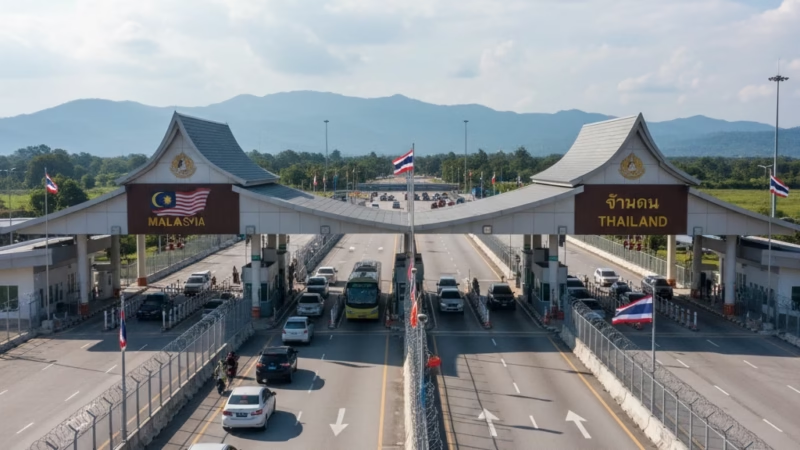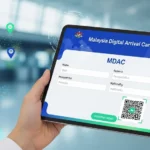How to Cross the Malaysia–Thailand Border by Land

Introduction
Planning to travel between Malaysia and Thailand? Crossing the border by land is one of the most scenic and affordable ways to explore Southeast Asia. Whether you’re backpacking, road-tripping, or heading for a weekend getaway, the journey is simple once you know the process. This step-by-step guide explains how to cross the Malaysia–Thailand border by land safely and efficiently, including transport options, required documents, and key entry points.
Step 1: Choose Your Border Crossing Point
There are several official land border crossings between Malaysia and Thailand. The most popular ones are:
- Bukit Kayu Hitam – Sadao (Kedah–Songkhla): The busiest and most convenient for buses and cars.
- Padang Besar – Padang Besar (Perlis–Songkhla): Ideal for train travelers.
- Wang Kelian – Wang Prachan (Perlis–Satun): Quieter, scenic route for road trippers.
- Rantau Panjang – Sungai Kolok (Kelantan–Narathiwat): Common for travelers heading to Southern Thailand.
Tip: For first-time travelers, Bukit Kayu Hitam and Padang Besar are the easiest and most tourist-friendly options.
Step 2: Prepare Your Travel Documents
Ensure you have:
- A valid passport with at least six months’ validity.
- A Thai visa (if required). Most ASEAN nationals, including Malaysians, can enter Thailand visa-free for 30 days.
- Entry and exit cards (TM6 form) — usually provided at the Thai border.
- Vehicle documents if driving (vehicle registration, insurance, and international driving permit).
Pro tip: Keep printed copies of your hotel bookings and return tickets. Immigration officers may ask to verify your travel plans.
Step 3: Choose Your Mode of Transport
You can cross the Malaysia–Thailand border by:
- Train: KTM Komuter and ETS trains connect Malaysia to Padang Besar, where you can transfer to Thailand’s Hat Yai-bound train.
- Bus/Minivan: Regular buses from Kuala Lumpur, Penang, and Alor Setar go directly to Hat Yai or Songkhla.
- Private Car or Taxi: Ideal for flexible travel, but ensure you have valid car insurance for Thailand.
- On Foot: Possible at some checkpoints (e.g., Padang Besar) for backpackers.
Example: A train from Kuala Lumpur to Padang Besar takes about 5.5 hours, followed by a quick transfer across the Thai border.
Step 4: Clear Malaysian Immigration
Before entering Thailand, you’ll need to stamp out of Malaysia. At the border post:
- Present your passport to Malaysian immigration.
- Receive an exit stamp.
- Proceed to the Thai immigration counter on the other side.
Tip: Keep your passport open to the photo page for faster processing.
Step 5: Enter Thai Immigration
Once on the Thai side:
- Submit your passport and completed arrival card.
- If eligible, receive a visa exemption stamp (usually 30 days).
- Check your passport stamp before leaving the counter.
Important: Make sure your entry stamp shows the correct number of days. Overstaying can result in fines or entry bans.
Step 6: Continue Your Journey in Thailand
After immigration, you can:
- Take a local bus, minivan, or train to nearby destinations such as Hat Yai, Songkhla, or Phuket.
- Exchange some Thai Baht at border money changers or use ATMs.
- Enjoy local food stalls near the border for a taste of authentic Thai flavors.
FAQs
1. Do I need a visa to enter Thailand?
If you’re from Malaysia or most ASEAN countries, no visa is required for stays under 30 days. For longer stays, apply in advance at the Thai Embassy.
2. Can I drive my Malaysian car into Thailand?
Yes, but you’ll need Thai car insurance, a valid international driving permit, and a “Vehicle Entry Permit” from the border checkpoint.
3. What’s the best border crossing for first-timers?
Padang Besar is easiest for train travelers, while Bukit Kayu Hitam offers the most direct road access.
Conclusion
Crossing the Malaysia–Thailand border by land is straightforward, budget-friendly, and filled with adventure. With your documents in order and the right border point chosen, you’ll enjoy a smooth transition from Malaysia’s lush landscapes to Thailand’s vibrant towns. Pack your essentials, follow the steps above, and get ready for a memorable overland journey through Southeast Asia














Comments are closed.